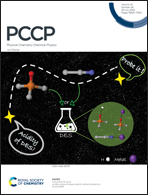Carbon phosphide nanoribbons with spatial inversion symmetry: robust generators of pure spin current with a photogalvanic effect
Abstract
Our recent work has demonstrated that the spin-dependent photogalvanic effect (PGE) is an ideal way to induce pure spin current in certain centrosymmetric systems (X. Tao, P. Jiang, H. Hao, X. Zheng, L. Zhang and Z. Zeng, Phys. Rev. B, 2020, 102, 081402), and thus the search for appropriate materials or structures is the key to realize it. Here, we theoretically propose a spin optoelectric device with α-phase carbon phosphide nanoribbons (α-CPNRs) to generate pure spin current by PGE using density functional theory simulation. By designing an α-CPNR based device with a centrosymmetric structure, due to the structural inversion symmetry and real space spin polarization antisymmetry of the system, the PGE induced pure spin current without any accompanying charge current can be always obtained, independent of polarization type and polarization angle of the photons. Furthermore, the magnitude of pure spin current can be greatly increased (nearly by an order of magnitude) by applying antiparallel electrical fields in the two leads to tune the spin density and band structure. Furthermore, by applying parallel electrical fields, a fully spin-polarized photocurrent can be produced in this system, suggesting a fantastic scheme to achieve half-metallic transport, another important goal in spintronics. These investigations suggest that the optoelectric devices constructed by α-CPNRs will have great potential in spintronics.



 Please wait while we load your content...
Please wait while we load your content...